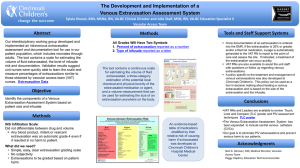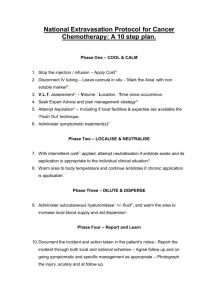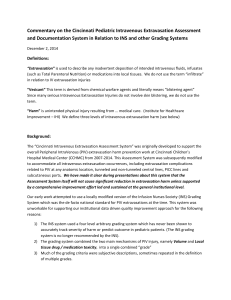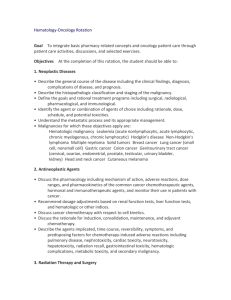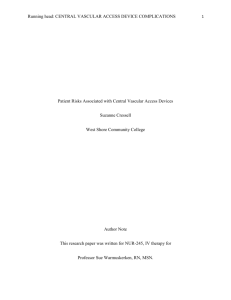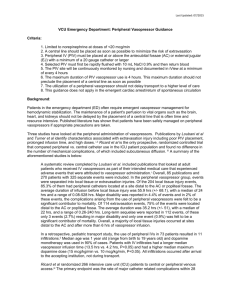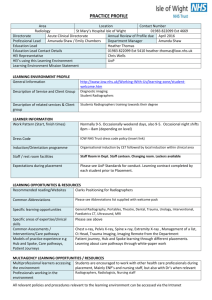Microsoft Word 2007 - University of the West of England
advertisement
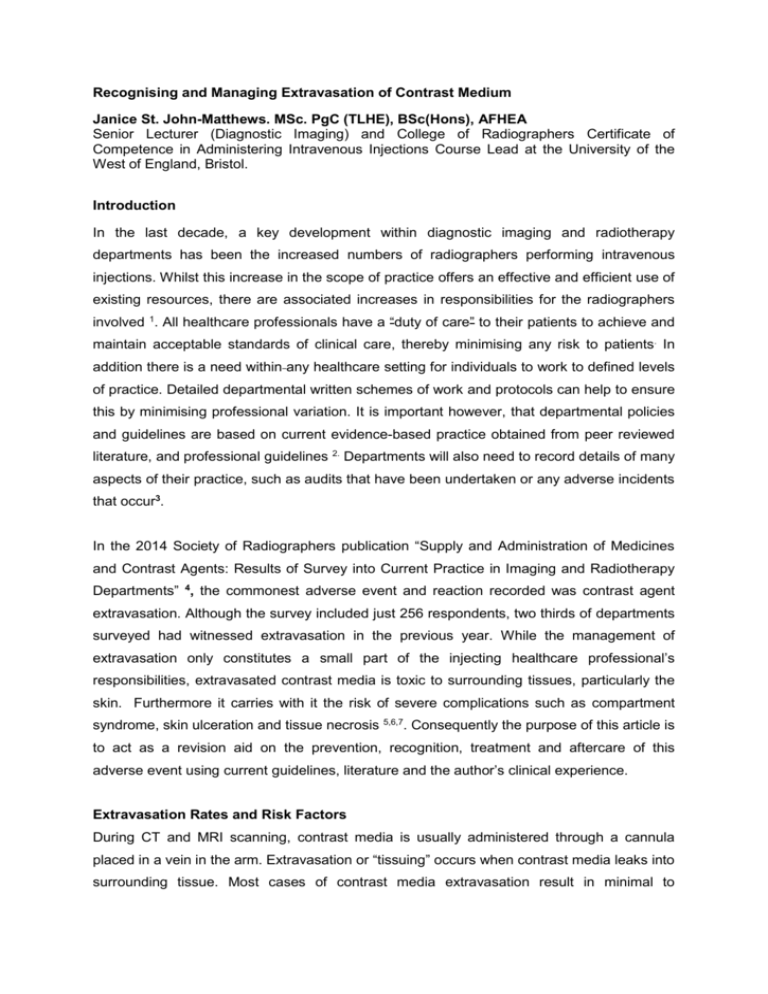
Recognising and Managing Extravasation of Contrast Medium Janice St. John-Matthews. MSc. PgC (TLHE), BSc(Hons), AFHEA Senior Lecturer (Diagnostic Imaging) and College of Radiographers Certificate of Competence in Administering Intravenous Injections Course Lead at the University of the West of England, Bristol. Introduction In the last decade, a key development within diagnostic imaging and radiotherapy departments has been the increased numbers of radiographers performing intravenous injections. Whilst this increase in the scope of practice offers an effective and efficient use of existing resources, there are associated increases in responsibilities for the radiographers involved 1. All healthcare professionals have a “duty of care” to their patients to achieve and maintain acceptable standards of clinical care, thereby minimising any risk to patients. In addition there is a need within any healthcare setting for individuals to work to defined levels of practice. Detailed departmental written schemes of work and protocols can help to ensure this by minimising professional variation. It is important however, that departmental policies and guidelines are based on current evidence-based practice obtained from peer reviewed literature, and professional guidelines 2. Departments will also need to record details of many aspects of their practice, such as audits that have been undertaken or any adverse incidents that occur3. In the 2014 Society of Radiographers publication “Supply and Administration of Medicines and Contrast Agents: Results of Survey into Current Practice in Imaging and Radiotherapy Departments” 4, the commonest adverse event and reaction recorded was contrast agent extravasation. Although the survey included just 256 respondents, two thirds of departments surveyed had witnessed extravasation in the previous year. While the management of extravasation only constitutes a small part of the injecting healthcare professional’s responsibilities, extravasated contrast media is toxic to surrounding tissues, particularly the skin. Furthermore it carries with it the risk of severe complications such as compartment syndrome, skin ulceration and tissue necrosis 5,6,7. Consequently the purpose of this article is to act as a revision aid on the prevention, recognition, treatment and aftercare of this adverse event using current guidelines, literature and the author’s clinical experience. Extravasation Rates and Risk Factors During CT and MRI scanning, contrast media is usually administered through a cannula placed in a vein in the arm. Extravasation or “tissuing” occurs when contrast media leaks into surrounding tissue. Most cases of contrast media extravasation result in minimal to moderate swelling and erythema and the majority of cases resolve without any reported adverse effects. However tissue damage from extravasated iodinated contrast material can be caused by the direct toxic effect of the agent and this can cause skin ulceration, soft tissue necrosis and in rare cases, compartment syndrome in rare cases. As recorded in literature, extravasation rates in adult patients remains low (0.13- 0.94%) 5,6,7,8,9,10,11,12 with technical and patient related characteristics constituting the main risk factors- table 1. The most important aspect of extravasation reduction is to reduce the risk. Technique related risk factors are attributed to: the use of power injectors; suboptimal injection sites, including lower limb and small distal veins; large volume of contrast medium; and high osmolar contrast media 8. It is also useful to establish the “age” of an in-situ venfalon as an older catheter maybe more likely to be thrombosed if not recently used. Patient related risk factors include: inability to communicate; fragile or damaged veins; arterial insufficiency; compromised lymphatic and/or venous drainage and obesity 9- table 2. All injecting healthcare professionals play an important role as executors of proper injection technique 13 . To guarantee those injecting continually work to the highest of standards cannulating radiographers should have appropriate training and assessment of competence; they should understand and follow local protocols and participate in auditing of their cannulation technique, whether this is at an individual or departmental level 14 . Intravenous technique should be meticulous, using appropriate sized plastic cannula placed in a suitable vein to handle the flow rate used during the injection. The first step is to ensure adequate venous access with an appropriate sized cannula whenever possible, as per local policies. Lines should be tested for patency and tolerance to high-flow injection rates established by briskly administrating normal saline 9, 12. Even with thorough preparation, extravasation can still occur 7, 15 and therefore it is important to detect extravasation as quickly as possible. Venous phase image acquisition allows the CT radiographer to remain in the room with the patient to monitor injection progress in the first 10-20 seconds. This is easily performed by speaking to the patient, watching and feeling the area around the injection site to establish if any swelling is occurring. On the other hand, when using bolus tracking software such as pulmonary angiography and cardiac scanning, this is not always possible due to radiation exposure. It is therefore imperative to maintain two-way communication with the patient throughout the examination. It is also important to advise the patient that they may feel an initial stinging sensation however if this sensation does not elapse or if they feel pain at the injection site then they need to advise the scanning team over the two-way intercom. Warning Signs & Symptoms Most patients experiencing extravasation will report a tightness, stinging/ burning sensation or swelling near the injection site, although some experience little or no discomfort. Some automated injectors are fitted with an extravasation detection accessory (EDA). In a study of 500 patients 16 these were found to be a safe and accurate monitoring tool. However, this is not without its issues, and is dependent on the level at which the EDA algorithm is set. This is demonstrated in supporting reference whereby the healthcare professional monitoring the injection noted extravastion before the EDA triggered, resulting in a volume of 9mls within the intravascular space in the patient. Furthermore the author observes few departments routinely use these devices. A synopsis of preventative measures can be found in table 3. Managing Extravasation The current recommended treatment for patients suffering from extravasation is laid out in the Royal College of Radiologist (RCR) “Standards for Intravenous Contrast Agent Administration to Adult Patients” 17 -table 3. These are based on recommendations made by the Contrast Media Safety Committee of European Society of Urogenital Radiology (ESUR) in the “ESUR Guidelines on Contrast Medium”18. As highlighted in the Society of Radiographers survey 4, 65.2% of respondents who reported extravasation used the RCR guidelines or local amendments to these standards while others used a local protocol which outlined the correct course of treatment. A possible difference in the outcomes of these two approaches may be attributed to the fact that guidelines represent general advice whereas local protocols offer an accepted code of behaviour in a particular situation 2. Nevertheless as demonstrated in a 2014 American study on technologists awareness of managing different levels of contrast extravasation19, the importance of ensuring that the injecting radiographer is au-fait with the most-up-to date local agreed that protocol which must reflect national guidelines Both the RCR and ESUR acknowledge that conservative management is adequate in most cases and advise elevating the affected limb; applying ice packs to the affected area and careful monitoring. However there is some debate in the literature pertaining to the effective treatment of mild contrast medium extravasation 5, 6, 16, 17 . It is believed that raising the affected limb aids in reducing oedema by decreasing capillary hydrostatic pressure 20, 21, 19. The rationale for applying cold compresses is that it results in vasoconstriction which may limit the development of inflammation. While the RCR guidelines don’t stipulate how long to apply the ice-packs for, the ESUR 21 recommend applying them to the injection site for 15-60 minutes three times a day for 1-3 days until symptoms resolve. Other literature describes the use of hot compresses so as to improve absorption as well as improving blood flow distal to the site 1. Nevertheless the author was unable to find any further literature to support and explain the reasons for doing this. Managing Severe Cases It is acknowledged that extravasation injuries are more severe in patients with low muscular mass or atropic subcutaneous tissues and patients with arterial, venous or lymphatic insufficiency maybe impacted more severely by these injuries 20, 21. In cases of severe injury RCR and ESUR guidelines state that the advice of a plastic surgeon should be sought. Immediate surgical consultation should be requested irrespective of the volume extravasated and should be solely based on the patient signs and symptoms. These may include: progressive swelling or pain, altered tissue perfusion, change in sensation in the affected limb and skin blistering or ulceration. In extreme cases an emergency fasciotomy maybe required to decompress neurovascular structures 14. Aftercare The RCR guidelines instruct that details of the incident plus any management advice given, should be recorded in the patient notes. Organising patients to remain under observation in the radiology department up-to 4 hours after the event may be useful, and if symptoms do not resolve quickly the patient should be admitted and monitored. One area where there is consensus in the literature and guidelines is the need to ensure that out-patients are given clear instructions to seek additional medical care should there be worsening of the symptoms of extravasation. While neither the RCR nor ESUR offer advice on how best to achieve this, the author’s personal experience is that providing the patient with a Patient Instruction Leaflet acts to reinforce verbal advice and ensures the patient receives formalised information. There is a plethora of literature to support this observation 22, 23, 24, 25. Areas for consideration within the leaflet may include: what happens next; risk; follow up advice and contact details, although the list is not exhaustive 22 . Another useful tool witnessed by the author is to organise a telephone follow-up with the patient within 24 hours to ascertain if there is any residual pain, changes in sensation and redness/ blistering. This also acts to reassure the patient 22. Conclusion Literature acknowledges that it is difficult to identify any one single factor that is likely to cause extravasation. In some cases extravasation is unavoidable, and the vast majority of patients in whom extravasations occur recover with only minor injuries and no complications. However, as noted in the introduction, all cannulating radiographers owe a “duty of care” to their patients and should ensure that best practice is followed when extravasation occurs. Given the morbidity associated with contrast media, regular review and implementation of local extravasation policy and individual practice is also essential. Acknowledgements Thank you to Dr. Vivien Gibbs, Ultrasound Programme Manager at the University of the West of England, for her support in writing this article. Word Count 1, 690 CPD Activity How can you use the information from this article to review your own practice as a cannulating Radiographer? Do you have a local extravasation policy? How could you use this article and the guidelines/literature cited to review this? Are Patient Information Leaflets useful? If you use them locally for extravasation advice how could they be improved? If you don’t, is this something that could be introduced in your department? Is there a need for more standardised training and a national approach to patient care following extravasation? It might be useful to have a description of what extravasation is (causes) and the complications associated with it – why is it a cause for concern? This has now been addressed in paragraph 2: Extravasation rates and risk factors. It might useful to include some images or diagrams of what extravasation looks like I am unsure where I can find these. Would it be satisfactory to reference one from another journal article? and warning signs and symptoms, etc. Page 2 has a new sub-heading Warning Signs & Symptoms so as to ease reader navigation. This section has been added to address this comment Could the author provide some recommendations in the conclusion or summary of key points. What might be done at departmental level e.g. should patients with extravasation be assessed by a radiologist, and referred to the Emergency Department in severe cases for example? Is there a need for more standardised training and a national approach with regards to patient care following extravasation e.g. follow up phone calls or leaflets? This has been placed as a CPD activity. As the CoR IV course lead at UWE it is my opinion that all radiographers who cannulate should have the CoR accredited qualification which covers this area. However I appreciate that this is not always possible given the large numbers of cannulating radiographers now in the UK and feel this is a worthy reflective activity. What preventative measures can be taken to reduce extravasation e.g. ensuring the IV site is properly selected, placed, secured, and tested or observation of the IV site for the first 10-20 seconds of the injection. New table, table 3, included to summarise points in section 2, p1: Extravasation Rates and Risk Factors duty of care” to their patients and should ensure that best practice – what is this? Ref 12 not cited in text? This has been corrected Table 1 doesn’t identify the risk factors suggested in text – The author needs to change so this reads correctly. Perhaps a bullet point list of extravasation risk factors would improve readability so key points jump out? New table, table 3, added to aid reader navigation of key points linked to risk factors. It’s Sistrom as author – would the author address this in the list and on table 1. Corrected Lots of the references are over 10 years old? Is there anything newer. Agree. A further “hand-search” has highlighted papers by Bond (2012); Kingston et al (2012) and Galia et al (2014) pertaining to extravasation which have now been included. The first reference, written in 2001, is a seminal piece arguing the case for Radiographers to cannulate and what would need to be in place to allow this extended practice. I feel this is important to include as it demonstrates how far we have developed our practice since then. The articles on the value of written information as a communication tool for patients have been chosen due to their relevance to extravasation cases22; radiography practice24 and because they represent key seminal literature on this topic 23, 25.

